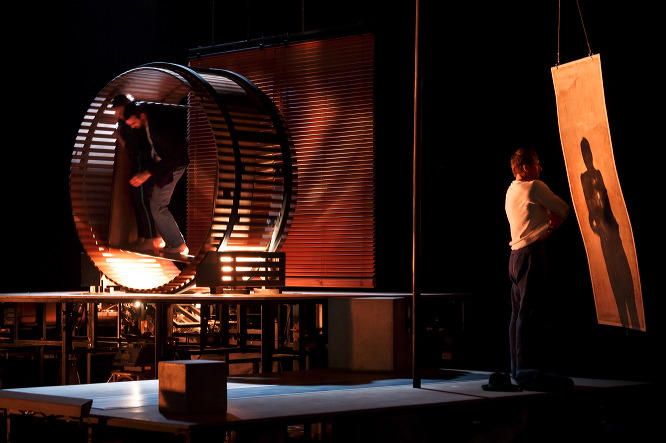Linbury Studio Theatre, Royal Opera House, Covent Garden, 11th January 2014

IMAGE: Christophe Raynaud de Lage
The set of untreated wood and simple steel-decking that awaits this French company has an easy-going, workshop aesthetic, where slatted blinds match the barrel-like sides of a giant wooden wheel, and a reel-to-reel tape player lies unobtrusively below one of the raised platforms. I know that Compagnie MPTA (Les Mains, Les Pieds et La Tête Aussi) will be using film projections and circus skills in this piece and, from my standing position on the lower balcony, I am a little concerned that the angles won’t be effective from my vantage point. I need not have worried; the visual elements are as precisely thought out as the choreography in this 60 minute homage to movement and potential.

IMAGE: Christophe Raynaud de Lage
Using performance techniques from traditional circus disciplines such as German Wheel, Chinese Pole and Wheel of Death acts, the three performers (Elise Legros, Cyrille Musy, and Mitia Fedotenko) are as intimately connected to the physical world around them as they are disconnected from each other – and their audience – on an emotional level. What we see is a laboratory for experiments in locomotion; a place where everyday walks and movements one might encounter in daily life are transported into a contextless realm for aesthetic value.
The French texts we hear played amid sounds of creaking wood and moving parts have been provided for us in printed English translations. Intending to read them as they occur, but then unable to in the darkened auditorium, I have only the vague understanding that they are all to do with the act of walking, and things that the human body can do.
And, in their transforming world, where nothing is fixed, this notion seems to be the circus heart that beats beneath MPTA’s multi-textured piece. The theatre-maker’s desire to communicate, or the dancer’s need to express, are overshadowed by the circus artist’s obsession with how the human body can work with the objects that surround it.

IMAGE: Christophe Raynaud de Lage
Our eye is continually drawn to movement in myriad forms; in patterns of light, in unexpected openings, in the highlighted codes of body language and daily interactions. Legros and Musy share an acrobatic duet that utilises the environment of each others’ body as much as the increasingly interesting set around them; Fedotenko displays a stunning mastery of his physical being as he replays motions of drunkenness and anxiety in a sequence of incredible physical comedy. Even during movements of passion, À Bas Bruit remains light, a knowing facsimile of the original, an illustration without emotional intensity.
A synchronised sequence against projected landscapes doesn’t seem to add much – unless to highlight how we often limit ourselves in our range of movement – and the ensuing juggling patterns performed with the three human bodies seems long-winded and unnecessary. But, perhaps, this hearkens back to the company’s ‘look what we can do’ circus sensibilities (director Mathurin Bolze worked with ground-breaking contemporary circus troupe Archaos, and was part of the seminal production Cri du Caméléon, created by Joseph Nadj for CNAC).

IMAGE: Christophe Raynaud de Lage
With the power of a silent film, that will not allow you to draw your eyes away for a moment, this show creates a dreamy state in the observer, reminding us of our universal abilities. We can be hopeful, and serene, and the final repeating phrase is one that even the anglophone audience can understand: ‘Patience. Ténacité. Endurance’.

